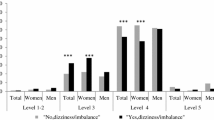Abstract
Dizziness is a common problem in patients seeking medical help and is often associated with imbalance and handicap. This study aimed to reveal whether the perception of unsteadiness could be an indication of greater imbalance and handicap in these patients. Patients with dizziness were categorized into two groups, steady patients (n=15) and unsteady patients (n=23), based on the presence or absence of self-perceived unsteadiness. The level of self-perceived handicap was evaluated by the Dizziness Handicap Inventory. Static balance ability was evaluated using a force platform and the center of pressure motion was calculated during various quiet standing conditions. Dynamic balance ability was evaluated by the functional forward reach test and Dynamic Gait Index. All the patients also went through isometric strength tests of the lower extremities. It was found that all patients reported themselves to be handicapped by dizziness. Patients who perceived themselves to be unsteady had greater handicap and poorer static standing, but did not differ from the steady patients in regard to muscle strength or functional balance tests. Thus, self-perceived unsteadiness was associated with greater handicap and poorer static balance in dizzy patients. In clinical management of these patients, special attention should be paid to balance and handicap.
Similar content being viewed by others
References
Baloh RW. The dizzy patient. Postgrad Med 105:161–172;1999.
Boult C, Murphy J, Sloane P, Mor V, Drone C. The relation of dizziness to functional decline. J Am Geriatr Soc 39:858–861;1991.
Cevette MJ, Puetz B, Marion MS, Wertz ML, Muenter MD. Aphysiologic performance on dynamic posturography. Otolaryngol Head Neck Surg 112:676–688;1995.
Colledge NR, Barr-Hamilton RM, Lewis SJ, Sellar RJ, Wilson JA. Evaluation of investigations to diagnose the cause of dizziness in elderly people: A community based controlled study. BMJ 313:788–793;1996.
Derebery MJ. The diagnosis and treatment of dizziness. Med Clin North Am 83:163–177;1999.
Duncan PW, Weiner DK, Chandler J, Studenski S. Functional reach: A new clinical measure of balance. J Gerontol 45:M192-M197;1990.
Furman JM, Cass SP: Balance Disorders: A Case-Study Approach. Philadelphia, Davis, iii;1996.
Gianoli G, McWilliams S, Soileau J, Belafsky P: Posturographic performance in patients with the potential for secondary gain. Otolaryngol Head Neck Surg 122:11–18;2000.
Gill-Body KM, Beninato M, Krebs DE: Relationship among balance impairments, functional performance, and disability in people with peripheral vestibular hypofunction. Phys Ther 80:748–758;2000.
Goebel JA, Sataloff RT, Hanson JM, Nashner LM, Hirshout DS, Sokolow CC. Posturographic evidence of nonorganic sway patterns in normal subjects, patients, and suspected malingerers. Otolaryngol Head Neck Surg 117:293–302;1997.
Griffiths MV. The incidence of auditory and vestibular concussion following minor head injury. J Laryngol Otol 93:253–265;1979.
Herdman SJ: Vestibular Rehabilitation, ed 2. Philadelphia, Davis, 477;2000.
Isaacson JE, Rubin AM. Otolaryngologic management of dizziness in the older patient. Clin Geriatr Med 15:179–191;1999.
Jacobson GP, Calder JH. A screening version of the Dizziness Handicap Inventory (DHI-S). Am J Otol 19:804–808;1998.
Jacobson GP, Newman CW. The development of the Dizziness Handicap Inventory. Arch Otolaryngol Head Neck Surg 116:424–427;1990.
Jacobson GP, Newman CW, Hunter L, Balzer GK. Balance function test correlates of the Dizziness Handicap Inventory. J Am Acad Audiol 2:253–260;1991.
Kendall FP, McCreary EK, Provance PG: Muscle Testing and Function, ed 4. Baltimore, Williams & Wilkins, 177–234;1993.
Mallinson AI, Longridge NS. Dizziness from whiplash and head injury: Differences between whiplash and head injury. Am J Otol 19:814–818;1998.
Mann GC, Whitney SL, Redfern MS, Borello-France DF, Furman JM. Functional reach and single leg stance in patients with peripheral vestibular disorders. J Vestib Res 6:343–353;1996.
Nazareth I, Yardley L, Owen N, Luxon L. Outcome of symptoms of dizziness in a general practice community sample. Fam Pract 16:616–618;1999.
Robertson DD, Ireland DJ. Dizziness Handicap Inventory correlates of computerized dynamic posturography. J Otolaryngol 24:118–124;1995.
Shumway-Cook A, Gruber W, Baldwin M, Liao S. The effect of multidimensional exercises on balance, mobility, and fall risk in community-dwelling older adults. Phys Ther 77:46–57;1997.
Sloane PD, Hill C. Dizziness in primary care. Results from the National Ambulatory Medical Care Survey. J Fam Pract 29:33–38;1989.
Stephens SDG, Hogan S, Meredith R. The desynchrony between complaints and signs of vestibular disorders. Acta Otolaryngol 111:188–192;1991.
Yardley L, Luxon LM, Haacke NP. A longitudinal study of symptoms, anxiety and subjective well-being in patients with vertigo. Clin Otolaryngol 19:109–116;1994.
Yardley L, Owen N, Nazareth I, Luxon L. Prevalence and presentation of dizziness in a general practice community sample of working age people. Br J Gen Pract 48:1131–1135;1998.
Yardley L, Putman J. Quantitative analysis of factors contributing to handicap and distress in vertiginous patients: A questionnaire study. Clin Otolaryngol 17:231–236;1992.
Young YH, Wu CH, Su YJ, Lee SJ, Hsin CH, Su MC. Dizziness and vertigo in the elderly. J Otolaryngol Soc ROC 30:414–417;1995.
Author information
Authors and Affiliations
Rights and permissions
About this article
Cite this article
Lin, SI., Tsai, TT., Lee, IH. et al. Perception of unsteadiness in patients with dizziness: Association with handicap and imbalance. J Biomed Sci 9, 428–435 (2002). https://doi.org/10.1007/BF02256537
Received:
Accepted:
Issue Date:
DOI: https://doi.org/10.1007/BF02256537




